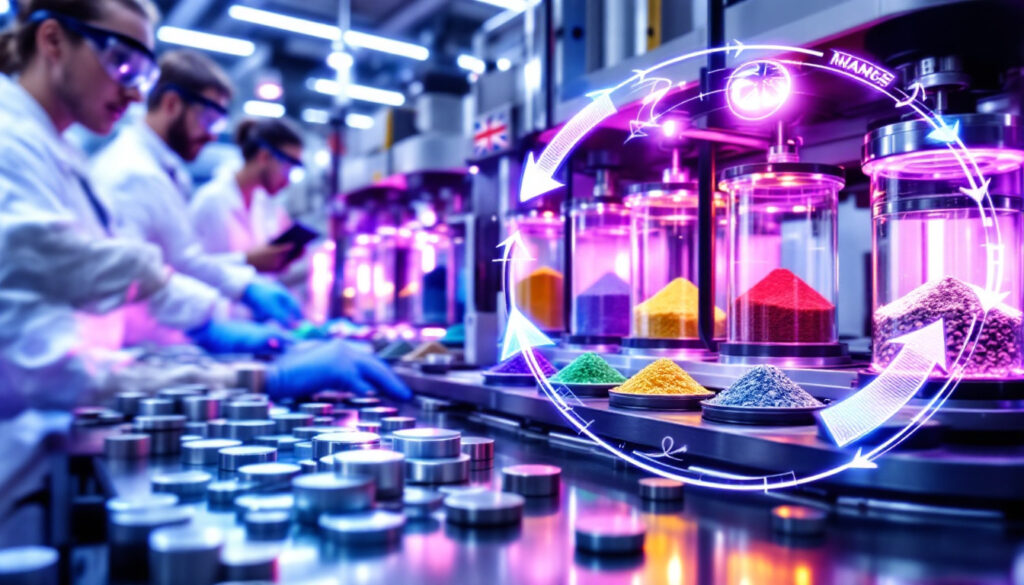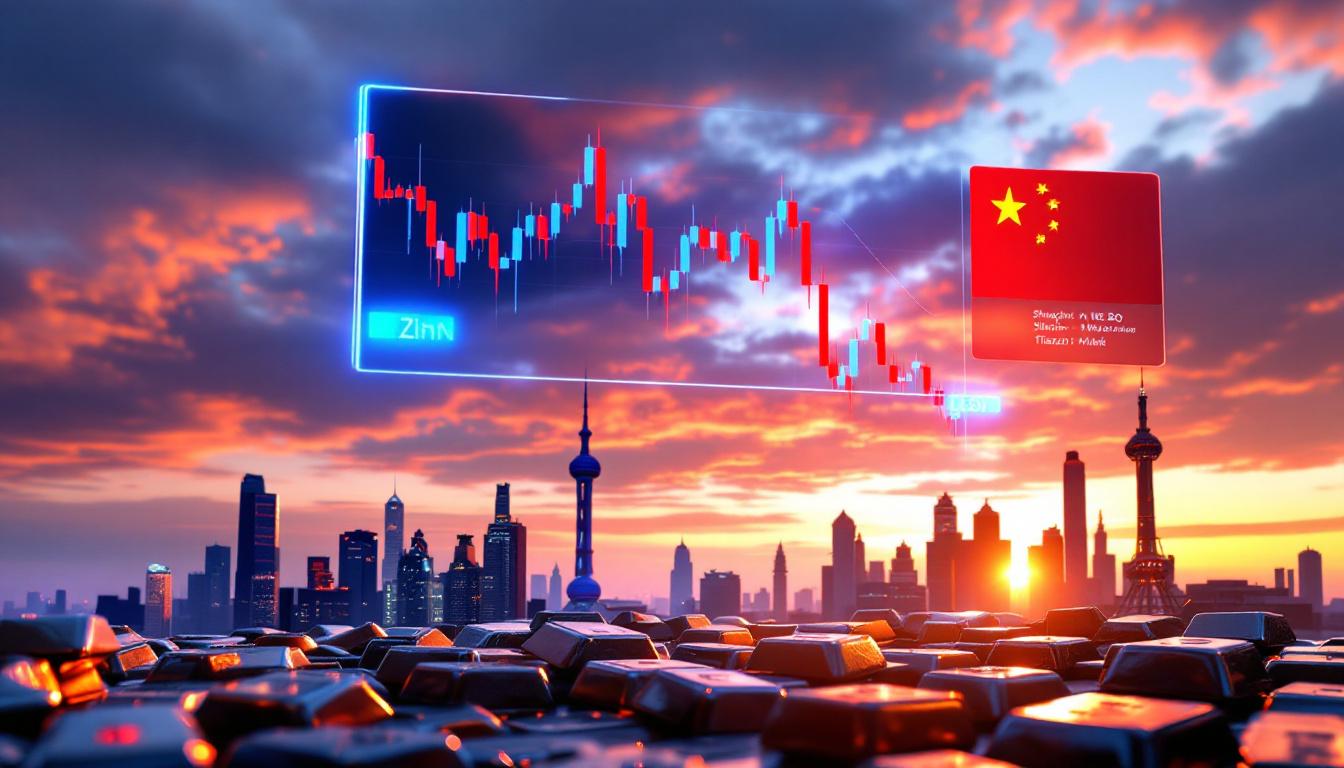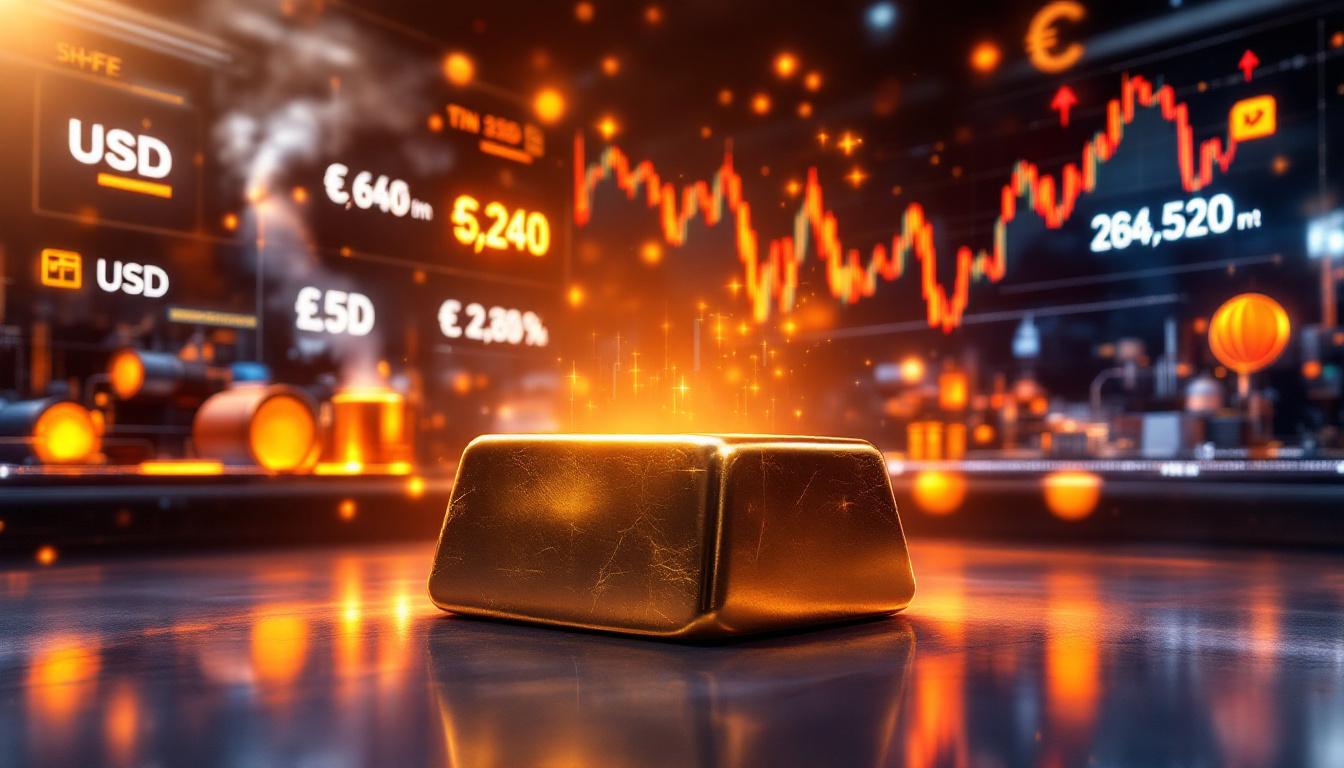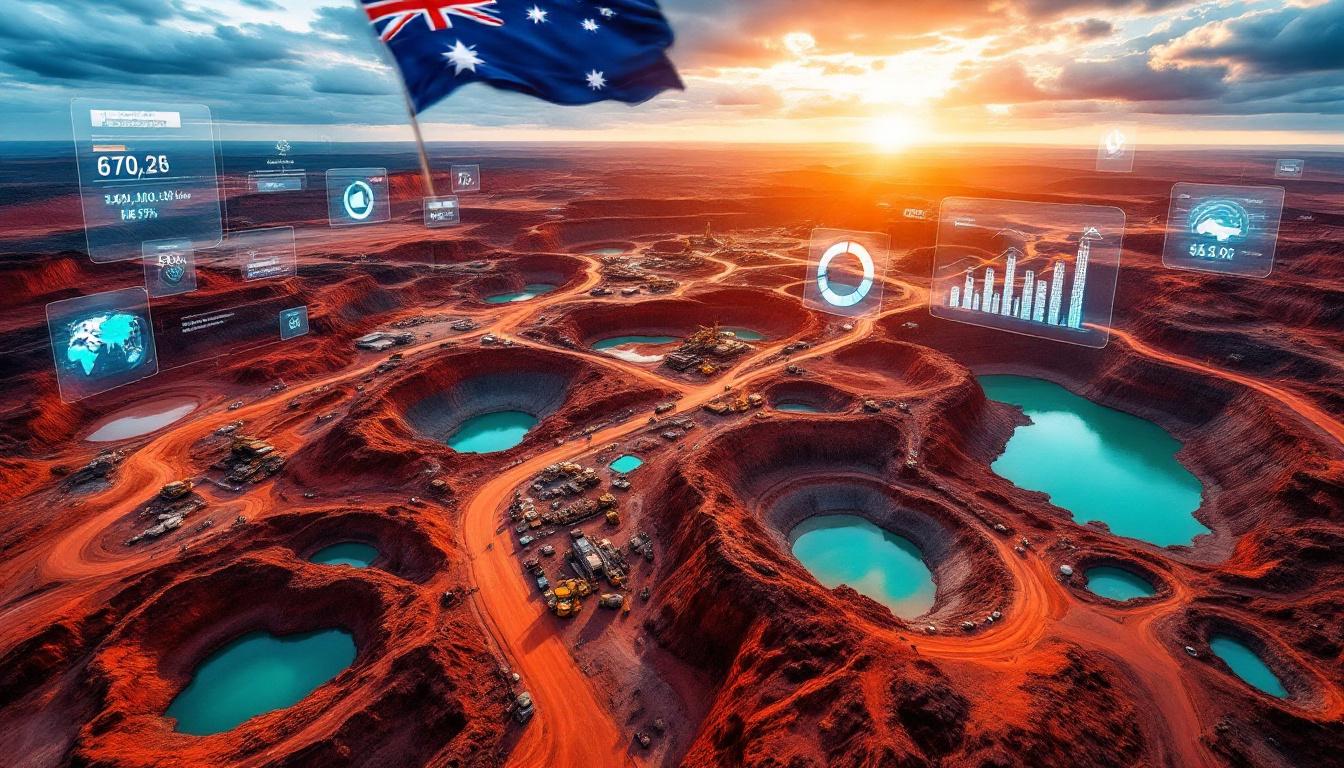UK Rare Earth Magnet Recycling Partnership: Ionic Rare Earths and EMR Join Forces
In a significant development for the UK's critical minerals strategy, Ionic Rare Earths Ltd (ASX:IXR, OTC:IXRRF) and European Metal Recycling (EMR) have formalized a partnership to revolutionize the domestic rare earth magnet recycling ecosystem. This collaboration marks a pivotal step in establishing sustainable critical minerals energy transition vital to the UK's clean energy transition and manufacturing independence.
What is the new partnership between Ionic Rare Earths and EMR?
Ionic Rare Earths and EMR have signed a non-binding Memorandum of Understanding (MoU) focused on developing a circular supply chain for rare earth permanent magnets in the United Kingdom. The agreement, finalized in May 2025, establishes a framework for the companies to jointly create a sustainable domestic source of recycled rare earth oxides (REOs).
The partnership follows Ionic's successful completion of a comprehensive feasibility study for their Belfast recycling facility in November 2024, which demonstrated the commercial viability of their proprietary technology for processing end-of-life magnets into high-purity REOs.
"EMR is a global recycler with deep expertise and a demonstrated commitment to advancing the circular economy," notes Tim Harrison, Managing Director of Ionic Rare Earths. "Their extensive infrastructure and experience in liberating rare earth magnets from complex waste streams perfectly complements our processing capabilities."
Dr. Charlotte Stamper, EMR's Head of Technology and Innovation, highlighted the strategic alignment: "This MoU empowers EMR to scale up recycling supply chains for rare earth magnets while supporting the UK's ambitions for resource security and net-zero transitions."
The collaboration focuses on "long-loop" recycling, enabling the complete transformation of end-of-life magnets into individual rare earth oxides that can be reincorporated into new high-performance magnets—a critical distinction from simpler recycling approaches that deliver lower-value outputs.
According to the UK Critical Minerals Intelligence Centre, domestic demand for rare earth elements could increase tenfold by 2030, driven primarily by electric vehicle production and offshore wind expansion. This partnership directly addresses this looming supply challenge.
How will the partnership strengthen the UK's rare earth supply chain?
The Ionic-EMR alliance creates a comprehensive domestic rare earth recycling ecosystem by combining complementary capabilities across the entire value chain:
- EMR brings extensive recycling infrastructure spanning 150+ sites globally, with specialized expertise in safely separating rare earth magnets from electronic waste, industrial equipment, and vehicle components
- Ionic contributes advanced processing technology capable of converting these recovered magnets into high-purity individual rare earth oxides
- Together, they establish a complete chain-of-custody from waste collection through to material production
The UK currently imports approximately 90% of its rare earth materials, according to the British Geological Survey's 2023 Critical Minerals Risk Assessment, creating significant supply vulnerabilities and economic dependence.
EMR has been at the forefront of several UK-based rare earth recovery initiatives, including:
- The REAP (Rare Earth Extraction from Audio Products) project targeting the recovery of over 1,000 tonnes annually from electronic waste
- SCREAM (Secure Critical Rare Earth Magnets for UK) developing innovative methods for magnet extraction from end-of-life vehicles
- Re-Rewind focusing on recovering rare earths from wind turbine generators nearing decommissioning
"EMR's extensive R&D in magnet recovery methodologies aligns perfectly with the UK's net-zero ambitions and resource security goals," explains Dr. Stamper. "We've developed specialized techniques for safely liberating these valuable materials from complex products without compromising their chemical properties."
The partnership directly supports the UK government's "Resilient Supply Chains" initiative launched in 2025, which identified rare earth elements as priority materials for domestic supply development. It also complements the recently established £2 billion Critical Minerals Investment Fund aimed at developing strategic material processing capabilities within the UK.
What technology will power the Belfast recycling facility?
Ionic's Proprietary Processing Technology
The Belfast facility leverages Ionic Technologies' groundbreaking hydrometallurgical process, which represents a significant advancement over conventional rare earth processing methods:
- Capable of processing both pre-consumer magnet manufacturing scrap and post-consumer end-of-life magnets
- Achieves individual rare earth oxide purities exceeding 99.5%—meeting or exceeding commercial specifications for magnet manufacturing
- Recovers critical magnet rare earths including neodymium (Nd), praseodymium (Pr), dysprosium (Dy), and terbium (Tb) with high efficiency
- Operates with significantly lower environmental footprint than primary mining operations
The process employs a proprietary combination of selective leaching, solvent extraction, and purification steps that allows for complete separation of individual rare earth elements—a crucial technical challenge in rare earth processing.
"What makes our technology unique is its ability to handle diverse feedstocks with varying compositions and contaminant profiles while consistently delivering ultra-high purity products," explains Dr. James Casson, Chief Technology Officer at Ionic Technologies. "We've designed the process specifically for the circular economy, optimizing for materials that will enter recycling streams."
Energy consumption per ton of recycled rare earth oxides is approximately 50% lower than primary extraction methods, according to internal assessments validated by independent engineering firms.
EMR's Recycling Expertise
EMR contributes essential capabilities in the critical pre-processing stages:
- Specialized techniques for identifying and safely extracting rare earth magnets from complex consumer electronics, industrial equipment, and automotive components
- Non-destructive liberation methods that preserve the chemical integrity of the magnetic materials
- Automated sorting systems utilizing AI and spectroscopic technologies to identify rare earth-containing components
- Demagnetization processes that enable safe handling and transport of recovered materials
EMR's existing infrastructure provides access to approximately 50,000 tonnes annually of end-of-life industrial equipment potentially containing rare earth magnets—a significant portion of the UK's recoverable material stream.
The company has developed proprietary methods for extracting intact magnets from hard disk drives with a recovery rate exceeding 95%, significantly higher than conventional shredding-based approaches that typically achieve only 60-70% recovery.
What are the environmental benefits of this recycling initiative?
Carbon Footprint Reduction
According to a comprehensive Life Cycle Assessment conducted by independent environmental consultancy Minviro in 2024, Ionic's recycling process delivers substantial environmental advantages:
- 61% lower carbon dioxide emissions compared to conventional mine-based rare earth oxide supply chains
- 80% reduction in water consumption versus primary mining operations
- 95% less solid waste generation through elimination of mining tailings and processing residues
- 70% decrease in acidification potential due to avoidance of ore processing chemicals
These environmental benefits stem from eliminating the most energy-intensive and environmentally damaging steps in traditional rare earth production: mining, crushing, grinding, and chemical separation of complex ores.
"When we examine the full environmental footprint, rare earth recycling represents one of the most impactful circular economy opportunities in critical materials," notes Dr. Maria Sundin, Principal Sustainability Consultant at Minviro. "The emissions avoidance potential is particularly significant given the carbon-intensive nature of conventional rare earth processing."
The process aligns with the EU Taxonomy's technical screening criteria for circular economy activities, potentially qualifying for sustainable finance initiatives that prioritize environmentally beneficial technologies.
Long-Loop Recycling Approach
The partnership emphasizes a long-loop recycling model that maximizes both material recovery and value creation:
- Accommodates magnets in various formats and conditions, including fully assembled devices, partially processed scrap, and manufacturing waste
- Recovers individually separated rare earth oxides at purities exceeding 99.5%, suitable for direct reuse in high-performance applications
- Creates a true circular material flow where elements can cycle indefinitely through the economy
- Preserves the full value and functionality of these critical elements without downcycling
This approach contrasts with short-loop recycling methods that typically produce lower-value mixed compounds or alloys with limited applications. The Ionic-EMR process delivers materials chemically identical to those from primary sources, enabling unlimited recycling cycles without performance degradation.
Why are rare earth magnets strategically important?
Critical Applications in Clean Energy Technologies
Rare earth permanent magnets, particularly neodymium-iron-boron (NdFeB) compositions, have become irreplaceable components in technologies driving the global energy transition:
- Electric vehicles: NdFeB magnets account for approximately 90% of EV traction motor designs (Adamas Intelligence, 2024), with each vehicle containing 1-2kg of rare earth elements
- Wind turbines: Direct-drive generators require approximately 1 tonne of rare earth magnets per megawatt of capacity (International Energy Agency, 2024)
- Energy-efficient motors: Industrial and consumer motors with rare earth magnets deliver 20-30% higher efficiency than conventional designs
- Consumer electronics: Smartphones contain approximately 0.1g of rare earths in speakers, vibration motors, and cameras
- Defense systems: Precision-guided munitions, radar systems, and communications equipment rely on rare earth components
The UK's ambitious climate targets—including banning new petrol and diesel vehicle sales by 2030 and achieving 50GW of offshore wind capacity by 2030—will dramatically increase domestic demand for these materials. The International Energy Agency projects that global demand for rare earth elements will grow by 200-600% by 2040, depending on the pace of clean energy deployment.
Supply Chain Vulnerabilities
The current global rare earth supply chain presents significant strategic challenges:
- China controls approximately 85% of global rare earth oxide production and over 90% of magnet manufacturing (USGS Mineral Commodity Summaries, 2024)
- Western processing capacity remains limited, with few facilities capable of high-purity separation
- Critical heavy rare earths like dysprosium and terbium face particular supply constraints
- Recent geopolitical tensions have highlighted supply chain vulnerability and price volatility
- Export restrictions have periodically been implemented by producing nations
These vulnerabilities have prompted strategic responses from multiple nations. The U.S. Defense Logistics Agency has been actively stockpiling rare earth materials since 2023, with holdings now reaching commercially significant levels. Similarly, the European Union's Critical Raw Materials Act established mandatory recycling targets for rare earths beginning in 2027.
"Rare earths represent perhaps the most concentrated supply chain vulnerability in the clean energy transition," notes Professor David Merriman, Research Director at Adamas Intelligence. "Recycling offers one of the fastest pathways to establishing domestic supply."
How does this partnership fit into Ionic's global strategy?
The EMR collaboration represents one component of Ionic Rare Earths' broader strategic approach to developing diversified rare earth supply chains across multiple geographies:
- South Korea: Similar MoU signed with DNA Link in Q4 2024 to develop Asian recycling capacity
- Brazil: Joint venture established with Viridis Mining and Minerals Ltd in Q1 2025 to develop heavy rare earth resources
- Uganda: Ongoing development of the Makuutu Rare Earths Project targeting 5,000 tonnes/year REO production by 2027
- Northern Ireland: Belfast recycling facility projected to process 500 tonnes/year of magnetic material by 2026
This multi-pronged approach allows Ionic to create a balanced portfolio spanning both primary mining and mining industry innovation operations, while establishing strategic positions in key markets across Europe, Asia, Africa, and South America.
"Our strategy intentionally combines primary and secondary sources to create a more resilient supply model," explains Tim Harrison. "The Belfast facility represents our most advanced recycling operation and serves as the blueprint for our global recycling expansion."
The company's focus remains particularly centered on heavy and magnet rare earths most critical to clean energy applications—elements facing the most significant supply constraints and price volatility. By developing multiple supply nodes, Ionic aims to mitigate geographical and political risks while establishing a leadership position in sustainable rare earth sourcing.
What commercial potential does the Belfast facility offer?
Following the comprehensive feasibility study completed in November 2024, the Belfast recycling facility demonstrates compelling commercial viability:
- Flexible feedstock handling: Ability to process multiple magnet sources including manufacturing scrap, hard disk drives, EV motors, and industrial equipment
- Scalable production: Initial capacity of 200 tonnes/year, expandable to 500+ tonnes/year
- Premium products: High-purity individual rare earth oxides commanding market prices of approximately $80/kg for NdPr oxide (Argus Media, 2025)
- Strategic value: First commercial-scale rare earth recycling facility in the UK with complete separation capabilities
- Strong partnerships: Secured feedstock access through the EMR collaboration and potential government contracts
The facility's economics benefit significantly from EMR's extensive network, which provides access to approximately 50,000 tonnes annually of end-of-life industrial and electronic equipment potentially containing rare earth magnets—far exceeding the facility's processing requirements.
"The Belfast operation demonstrates that rare earth recycling can be commercially viable today, not just environmentally necessary," notes financial analyst Sarah Chen of Resource Capital Markets. "With magnet rare earth prices projected to rise 40% by 2030 due to EV demand, the economics will only improve."
The UK government's £2 billion Critical Minerals Investment Fund, established in 2024, provides potential access to additional growth capital as the facility demonstrates commercial success. Initial discussions with the fund have been positive, according to company statements.
What are the next steps for implementation?
While the MoU is non-binding, it establishes a clear framework for collaboration between Ionic and EMR. The implementation roadmap includes:
- Technical planning (Q3 2025): Detailed engineering for magnet collection, pre-processing, and transportation logistics
- Feedstock qualification (Q4 2025): Testing and characterization of various magnet sources from EMR's waste streams
- Supply agreements (Q1 2026): Establishment of formal binding contracts for material supply and processing
- Scaling operations (2026-2027): Gradual capacity expansion as feedstock volumes increase
- Government engagement: Ongoing discussions with UK authorities regarding policy support and potential incentives
The partners are also exploring potential participation in the UK's Critical Minerals Accelerator grant program, which provides matching funding for projects advancing domestic supply chain development.
"We're moving quickly from planning to implementation," states Harrison. "The technical foundations are solid, and with EMR's extensive infrastructure already in place, we can accelerate the timeline compared to typical resource projects."
FAQ: Rare Earth Magnet Recycling Partnership
What types of products contain recyclable rare earth magnets?
Rare earth magnets are found in numerous consumer and industrial products, including:
- Computing equipment: Hard disk drives (containing approximately 10-20g of NdFeB per unit)
- Electric vehicles: Motors and sensors (1-2kg per vehicle)
- Wind turbines: Permanent magnet generators (up to 600kg per MW)
- Audio equipment: Speakers, headphones, microphones (0.1-5g per device)
- Industrial motors: High-efficiency drives (50g-5kg depending on size)
- Medical equipment: MRI machines (up to 1.5 tonnes per unit)
The concentration of these magnets varies significantly by application, with some industrial and medical equipment containing particularly high-value concentrations that make them priority targets for recycling efforts.
How does recycling rare earths compare to mining them?
Recycling rare earth elements offers several quantifiable advantages over primary mining:
- Carbon emissions: 61% lower CO₂ emissions per kg of rare earth oxide produced
- Water usage: 80% reduction in water consumption
- Land disturbance: Near-zero compared to approximately 300m² per tonne for mining
- Waste generation: 95% less solid waste produced
- Chemical usage: 70% reduction in process chemicals required
- Energy consumption: 50% lower energy requirements per kg of final product
The current global recycling rate for rare earth elements remains below 5% according to the UN Environment Programme's 2023 assessment, highlighting the significant untapped potential in this sector.
Renewable energy mining solutions and mine reclamation innovations continue to improve the environmental profile of traditional mining, yet recycling still offers substantial advantages in most impact categories.
What challenges exist in rare earth magnet recycling?
Despite its benefits, rare earth recycling faces several technical and economic challenges:
- Identification complexity: Magnets are often embedded within complex assemblies without clear labeling
- Collection infrastructure: Limited systems for separating rare earth-containing components from general waste
- Processing chemistry: Achieving high purity levels requires sophisticated separation technologies
- Economic competition: Primary production, particularly from regions with lower environmental standards, can offer lower costs
- Material variation: Inconsistent composition and quality of recycled materials requires flexible processing
- Historical design: Products manufactured without consideration for end-of-life recovery
Current recovery rates using conventional methods average
Looking for The Next Major Mineral Discovery?
Discover significant ASX mineral discoveries the moment they're announced with Discovery Alert's proprietary Discovery IQ model, which transforms complex data into actionable investment insights. Explore why historic discoveries can generate substantial returns by visiting the Discovery Alert discoveries page and start your 30-day free trial to position yourself ahead of the market.




